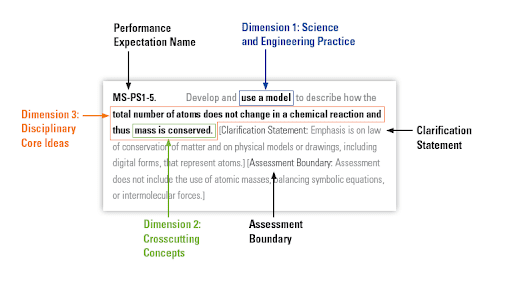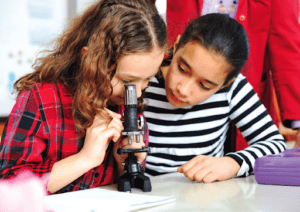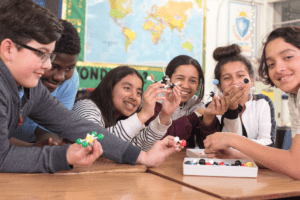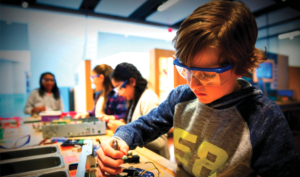
TCI’s Bring Science Alive! programs are designed to meet the Next Generation Science Standards (NGSS). From intriguing phenomena that get students asking questions to robust hands-on investigations, TCI’s programs make NGSS come alive.
About the Next Generation Science Standards (NGSS)
“The actual doing of science or engineering can pique students’ curiosity, capture their interest, and motivate their continued study.”
The Next Generation Science Standards (NGSS) were written to change the way science is taught in K–12 classrooms and reflect recent advances in science, technology, and the understanding of how students learn. NGSS aims to help students prepare for college, 21st-century careers, scientific literacy needed as citizens, and competition in an increasingly global economy.
Performance Expectations
NGSS standards are called performance expectations and are worded to explain what students should be able to do in assessments at the completion of a unit of study. The performance expectations are built on the foundation provided by A Framework for K-12 Science Education (2012).
Every performance expectation integrates the three dimensions described in the Framework: Science and Engineering Practices, Crosscutting Concepts, and Disciplinary Core Ideas. Also included in the performance expectations are clarification statements—providing examples and other details—and assessment boundaries to guide test development. The graphic shows an example of how all the pieces result in a coherent standard to guide instruction.
Three Dimensional Learning
NGSS is considered “three dimensional learning,” as it emphasizes three core concepts: Science and Engineering Practices, Disciplinary Core Ideas, and Crosscutting Concepts.
Dimension 1: Science and Engineering Practices
Science and Engineering Practices (SEPs), such as “developing and using models,” describe how actual scientists and engineers work. Students develop the ability to use these SEPs by investigating the natural and designed worlds. While engaged in SEPs, students deepen their understanding of the content described by the Disciplinary Core Ideas and Crosscutting Concepts. The eight SEPs involve ways of thinking about investigations and engineering problems. They also integrate mathematics and social interactions. Without any particular order implied, these SEPs help define what has been called “scientific inquiry” and “engineering processes.”
Dimension 2: Crosscutting Concepts
Crosscutting Concepts (CCCs), such as “patterns” and “cause and effect,” are the themes that organize students’ understanding of science and engineering in the same way that scientists and engineers do. They can also be thought of as lenses all students should use as they explore and describe phenomena related to the three science disciplines—physical, earth and space, and life sciences. These “big picture” CCCs are important in helping students make connections across all disciplines of science and engineering.
Dimension 3: Disciplinary Core Ideas
Disciplinary Core Ideas (DCIs) are focused statements of content specific to the three science disciplines (physical, earth and space, and life sciences) or to engineering. There are a limited number of DCIs, avoiding “mile wide, inch deep” curricula. Limiting the number of science concepts is to allow students the time they need to learn Science and Engineering Practices through investigations. NGSS core ideas assume that students have mastered the content of previous grades and are ready for more advanced learning.
TCI’s Approach to NGSS
TCI’s Bring Science Alive! programs for elementary and middle school classrooms are designed for NGSS. We ensure the three dimensional standards are covered so teachers can focus on aiding students in developing scientific skills, such as observation, inquiry, argument, collaboration, and communication.
 Explaining Phenomena
Explaining Phenomena
TCI’s phenomenon-based unit storylines provide real-world problems for students to connect their learning with their own experiences. Hands-on investigations enable students to explore, explain, and make sense of phenomena.
Designing Solutions
TCI’s engineering challenges and investigations engage students to design solutions directly relating to Disciplinary Core Ideas. The consistent engineering design process in Bring Science Alive!’s engineering challenges provides a clear road map for approaching design problems. Using it, students will decide when to define the problem, develop possible solutions, and optimize their designs.
Each engineering challenge focuses on one or two easy-to-learn engineering skills. After completing the program, students will have a full set of tools for tackling any design problem.
 NGSS-Based Units
NGSS-Based Units
Each and every lesson focuses on at least one Science and Engineering Practice, one Disciplinary Core Idea, and one Crosscutting Concept. Each dimension is selected to support learning as it relates to the performance expectation.




 Explaining Phenomena
Explaining Phenomena
 NGSS-Based Units
NGSS-Based Units

